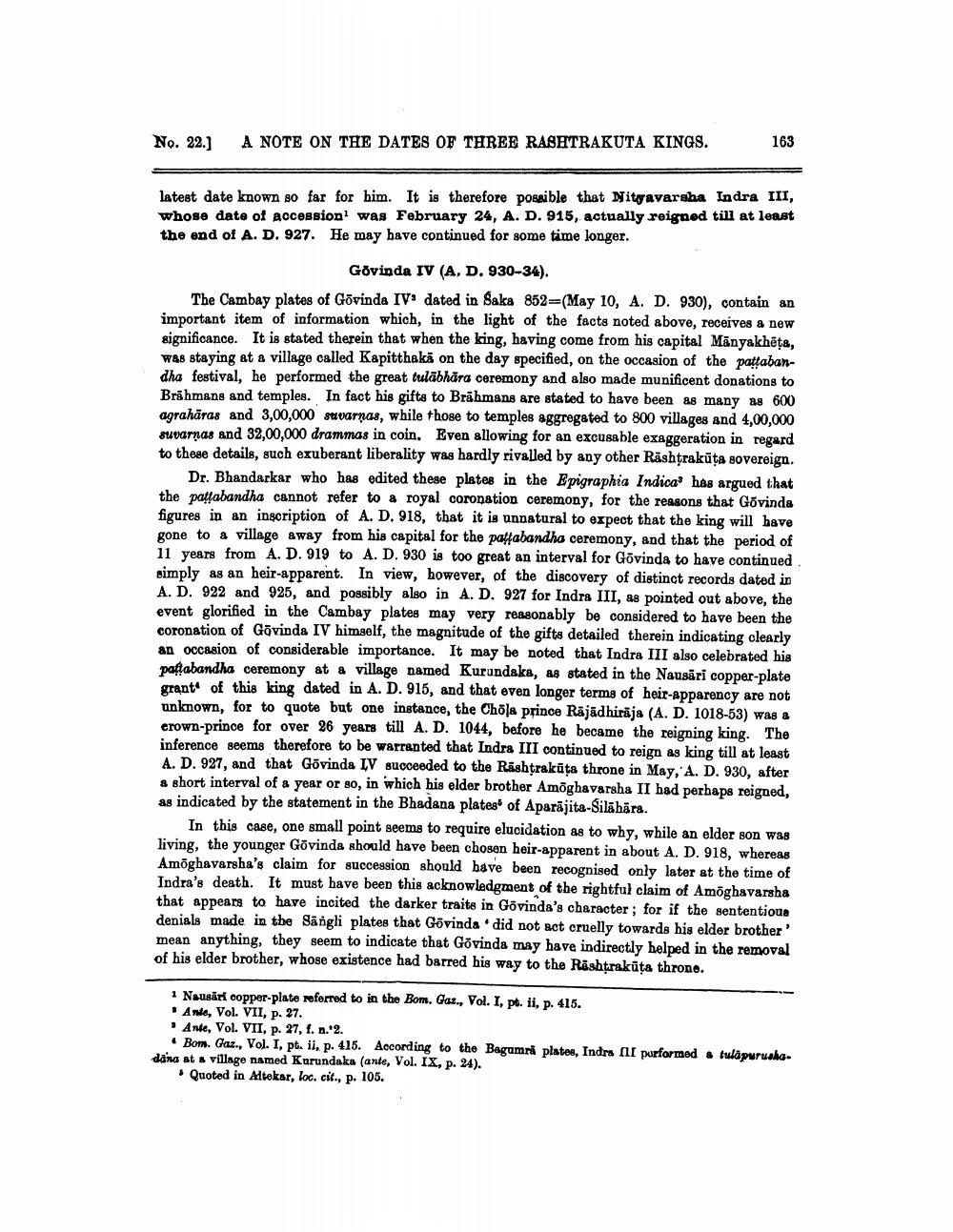________________
163
No. 22.)
A NOTE ON THE DATES OF THREE RASHTRAKUTA KINGS.
latest date known 80 far for him. It is therefore possible that Nityavarsha Indra III, whose date of accession was February 24, A. D. 915, actually reigned till at least the end of A. D. 927. He may have continued for some time longer.
Govinda IV (A, D. 930-34). The Cambay plates of Govinda IV: dated in Saka 852-(May 10, A. D. 930). contain an important item of information which, in the light of the facts noted above, receives a new significance. It is stated therein that when the king, having come from his capital Mänyakhēts, was staying at a village called Kapitthakä on the day specified, on the occasion of the pattabandha festival, he performed the great tulābhāra ceremony and also made munificent donations to Brahmans and temples. In fact his gifts to Brāhmans are stated to have been as many as 600 agrahāras and 3,00,000 suvarnas, while those to temples aggregated to 800 villages and 4,00,000 suvarnas and 32,00,000 drammas in coin. Even allowing for an excusable exaggeration in regard to these details, such exuberant liberality was hardly rivalled by any other Räshțrakūta sovereign.
Dr. Bhandarkar who has edited these plates in the Epigraphia Indica' has argued that the patfabandha cannot refer to a royal coronation ceremony, for the reasons that Govinda figures in an inscription of A. D. 918, that it is unnatural to expect that the king will have gone to a village away from his capital for the paffabandha ceremony, and that the period of 11 years from A. D. 919 to A. D. 930 is too great an interval for Govinda to have continued simply as an heir-apparent. In view, however, of the discovery of distinct records dated in A. D. 922 and 925, and possibly also in A. D. 927 for Indra III, as pointed out above, the event glorified in the Cambay plates may very reasonably be considered to have been the coronation of Govinda IV himself, the magnitude of the gifts detailed therein indicating clearly an occasion of considerable importance. It may be noted that Indra III also celebrated his paftabandha ceremony at & village named Kurundaka, as stated in the Nausāri copper-plate grant of this king dated in A. D. 915, and that even longer terms of heir-apparency are not unknown, for to quote but one instance, the Chola prince Rajadhiraja (A. D. 1018-53) was a crown-prince for over 20 years till A. D. 1044, before he became the reigning king. The inference seems therefore to be warranted that Indra III continued to reign as king till at least A. D. 927, and that Govinda IV succeeded to the Rashtrakūta throne in May, A. D. 930, after a short interval of a year or so, in which his elder brother Amõghavarsha II had perhaps reigned, as indicated by the statement in the Bhadana plates of Aparājita-Silāhāra.
In this case, one small point seems to require elucidation as to why, while an elder son was living, the younger Govinda should have been chosen heir-apparent in about A. D. 918, whereas Amõghavarsha's claim for succession should have been recognised only later at the time of Indra's death. It must have been this acknowledgment of the rightful claim of Amõghavarsha that appears to have incited the darker traits in Govinda's character; for if the sententioua denials made in the Sangli plates that Govinda did not act cruelly towards his elder brother' mean anything, they seem to indicate that Govinda may have indirectly helped in the removal of his elder brother, whose existence had barred his way to the Rashtrakūta throno.
1 Nausar copper-plate referred to in the Bom. Gas., Vol. I, pt. ii, p. 415.
Asie, Vol. VII, p. 27.
Ante, Vol. VII, p. 27, f. n.'2. • Bom. Gaz., Vol. I, pt. ii, p. 415. According to the Bagumri plates, Indra Af purformed a tulapuruska. dana at & village named Kurundaka (ante, Vol. IX, p. 24).
Quoted in Altekar, loc. cit., p. 105.




